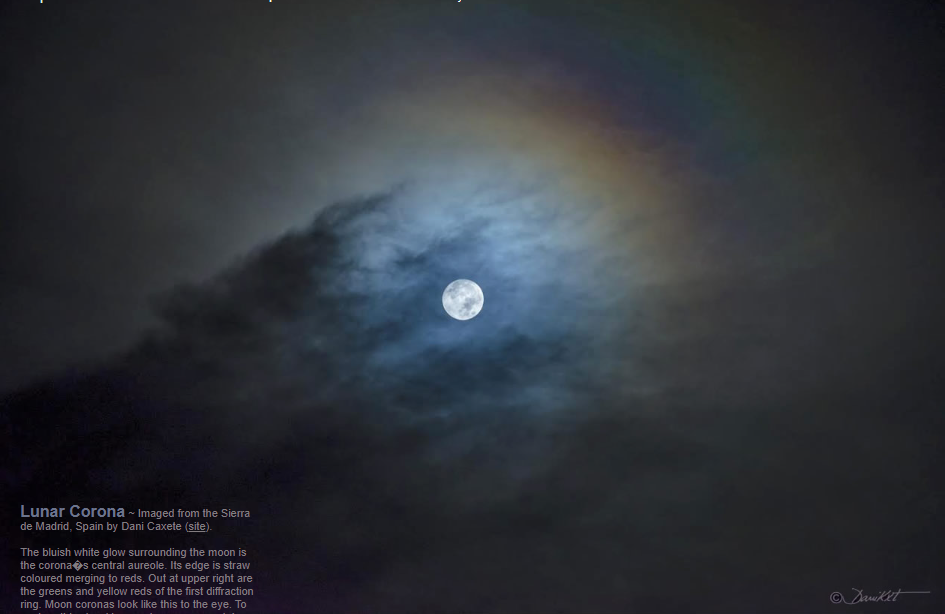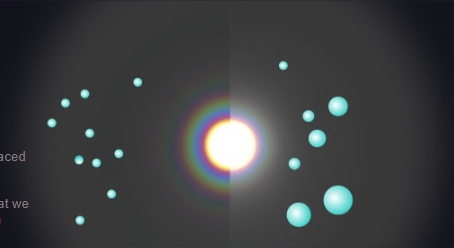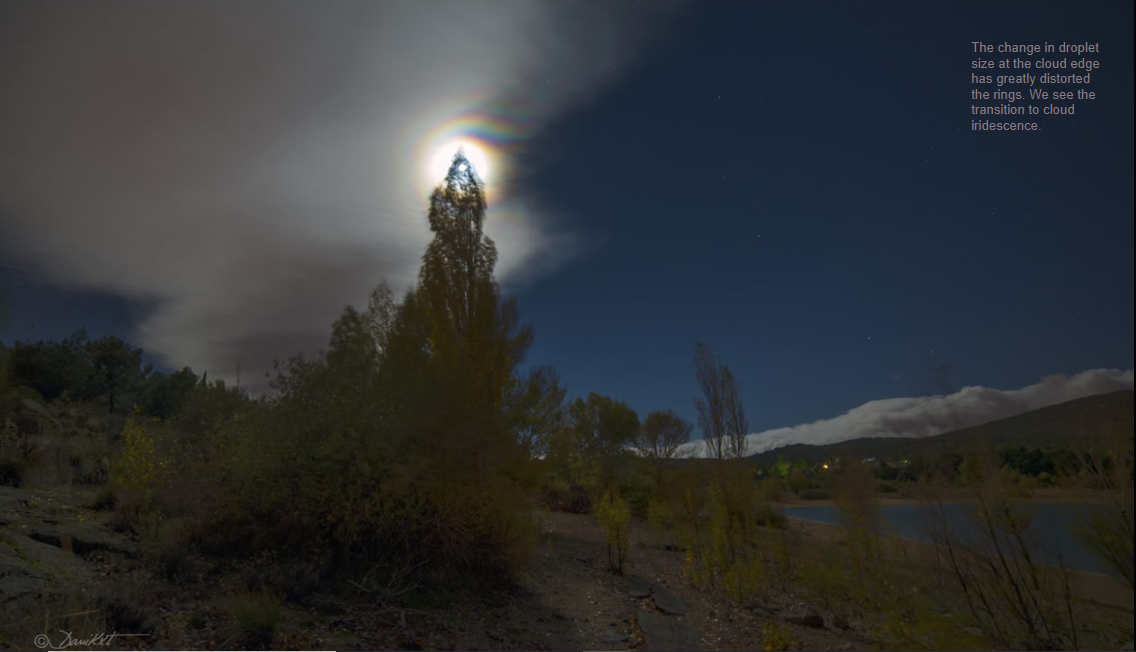Lunar Corona, Spain - OPOD
Lunar Corona, Spain - OPOD: A Spectacular Optical Phenomenon
Lunar corona, a captivating atmospheric optical phenomenon, was beautifully captured in an image taken from the Sierra de Madrid in Spain by photographer Dani Caxete. The image showcases the bluish white glow surrounding the moon, known as the corona's central aureole, which gradually transitions from straw-colored to red hues at its edges. Additionally, the image reveals the presence of greens and yellow-reds forming the first diffraction ring. This visual representation of moon coronas is a rare sight to behold with the naked eye, requiring fortuitous cloud cover to dim the moon's brightness and the skillful use of photography techniques to capture its essence.
Coronae, such as the lunar corona depicted in the image, arise from the diffraction of sunlight or moonlight by clouds composed of randomly spaced water droplets. It is important to note that these droplets are not evenly spaced, contrary to a common misconception. Each individual droplet generates its own unique diffraction pattern, contributing to the collective display of diffraction glints visible in the sky. The intricate dance of light and water droplets results in the formation of the mesmerizing lunar corona.
The appearance of the lunar corona is influenced by the size distribution of the water droplets within the cloud. The greater the spread in droplet sizes, the fewer diffraction rings are observed. This can be observed in IRIS Mie scattering calculations, which illustrate how monosized droplets and those with a Gaussian distribution of sizes produce different coronal patterns. The delicate colors and intricate rings visible in lunar coronae are a testament to the collective diffraction effects of millions of water droplets suspended in the atmosphere.
While the first image showcases the lunar corona's central aureole and the first diffraction ring, another photograph provides a more detailed view of the diffraction rings and their delicate colors. However, this enhanced visibility comes at the cost of overexposing the moon, resulting in a loss of detail. Nevertheless, both images highlight the remarkable beauty and complexity of lunar coronae.
In some instances, the presence of cloud edges can introduce variations in droplet size, leading to distorted rings within the corona. This distortion is particularly evident in the transition to cloud iridescence, where the change in droplet size at the cloud's edge alters the appearance of the diffraction rings. This phenomenon adds an extra layer of intrigue to the already captivating lunar corona.
In conclusion, the lunar corona is a breathtaking atmospheric optical phenomenon that results from the diffraction of sunlight or moonlight by water droplets suspended in clouds. The intricate interplay between light and water droplets creates a visual spectacle, with delicate colors and diffraction rings forming around the moon. Capturing the beauty of lunar coronae requires a combination of fortuitous cloud cover and skilled photography techniques. Whether witnessed with the naked eye or through the lens of a camera, lunar coronae serve as a reminder of the awe-inspiring wonders that can be found in our atmosphere.

Lunar Corona ~ Imaged from the Sierra de Madrid, Spain by Dani Caxete (site).
The bluish white glow surrounding the moon is the corona�s central aureole. Its edge is straw coloured merging to reds. Out at upper right are the greens and yellow reds of the first diffraction ring. Moon coronas look like this to the eye. To capture this visual impression on camera takes a fortuitous cloud to dim the moon and photographic skill.
All images ©Dani Caxete, shown with permission

Coronae arise from diffraction of sunlight or moonlight by clouds of randomly spaced water droplets. Not evenly spaced as claimed in this Univ of Illinois howler!
Each droplet produces its own diffraction pattern. And what we see in the sky is a sky transform - the collective diffraction glints from millions of drops.
IRIS Mie scattering calculations for monosized drops at left and ones with a 20% standard deviation Gaussian distribution of sizes at right.
The greater the spread in droplet sizes, the fewer the rings.

This more 'usual' corona photograph shows the diffraction rings and their delicate colours to greater perfection but at the cost of .overexposing the moon.

The change in droplet size at the cloud edge has greatly distorted the rings. We see the transition to cloud iridescence.
Note: this article has been automatically converted from the old site and may not appear as intended. You can find the original article here.
Reference Atmospheric Optics
If you use any of the definitions, information, or data presented on Atmospheric Optics, please copy the link or reference below to properly credit us as the reference source. Thank you!
-
<a href="https://atoptics.co.uk/blog/lunar-corona-spain-opod/">Lunar Corona, Spain - OPOD</a>
-
"Lunar Corona, Spain - OPOD". Atmospheric Optics. Accessed on November 26, 2024. https://atoptics.co.uk/blog/lunar-corona-spain-opod/.
-
"Lunar Corona, Spain - OPOD". Atmospheric Optics, https://atoptics.co.uk/blog/lunar-corona-spain-opod/. Accessed 26 November, 2024
-
Lunar Corona, Spain - OPOD. Atmospheric Optics. Retrieved from https://atoptics.co.uk/blog/lunar-corona-spain-opod/.